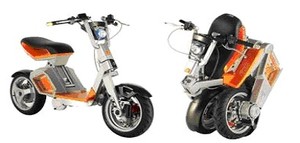Smart Transportation: Mobility-on-Demand
A Vision for CityCars and Smart Cities from MIT Media Lab's Smart Cities' Group
Most of the world's car-sharing programs are currently two-way programs. You pick up a car, like a Zipcar, at a convenient location, and then return the car to the same place you picked it up. Most bike-sharing programs, like Paris' popular Velib, are one-way. You pick up a bike at any location, ride it to your destination, and drop it off there. And, when you need another one, you pick it up at a different location. These mobility-on-demand systems are complex ecosystems comprised of many partners. The good news is that it IS possible to design and continuously improve customer-centric ecosystems. Customers love to participate in co-designing and in streamlining these kinds of systems to meet their common needs and to address common issues. As we start investing in our next generation of environmentally-sustainable mobility systems, let's make sure that we're building solutions that customers will actually use!
NETTING IT OUT
MIT’s Smart Cities’ program has an ambitious and seductive vision for the future of urban transportation: Combine mass transit with one-way electric vehicle-sharing programs to provide mobility-on-demand so that many people won’t need to drive their own cars into and around the city.
Offer people a selection of bicycles, electric motor scooters, electric cars and vans that they can easily find throughout the city, pick up and drive to their destination, and leave for the next person to use. These shared-use electric vehicles automatically recharge themselves when they’re parked.
Network these vehicles together into real-time information systems to become mobility networks. These intelligent mobility networks can adapt themselves to respond to energy usage, traffic congestion, and parking capacity. Through dynamic pricing, customers can be encouraged to redistribute the vehicles to the places they’re needed most.
How close is this vision to becoming a reality? Can we really use this approach to reduce pollution, traffic, noise, and greenhouse gases in the world’s most congested cities?
In order to succeed, mobility-on-demand solutions should be designed as customer-centric ecosystems. All the players in a public/private partnership ideally need to align around end-customers’ moments of truth and success metrics. Otherwise, we can build it, but they won’t come.
MIT’S MOBILITY-ON-DEMAND PROJECT
At the MIT Smart Customization Seminar in November 2009, Professor William J. Mitchell gave a wonderful presentation about the design of mobility-on-demand solutions for urban transportation. He introduced three new vehicles: the CityCar, the RoboScooter, and the Green Wheel, an electric-assist bicycle.
These new electric vehicles are the fruits of the Smart Cities initiative that is underway at MIT’s Media Lab. The goal: develop green transportation systems for people who live and work in cities. As Bill Mitchell explains, the key is to think in terms of mobility, not transportation. “Match the mobility needs to the mobility demands in every circumstance.”
Innovations and Learnings
MIT’s Mobility-on-Demand project is a good example of cross-disciplinary innovation combined with customer-led innovation resulting in smart (adaptive, learning) green (sustainable) solutions. MIT’s Mobility-on-Demand program builds on the lessons learned from observing customer behavior in dozens of vehicle-sharing programs around the world.
In addressing mobility-on-demand, the MIT Smart Cities’ team has contributed at least three new innovations:
- A robot wheel that includes an electric engine and all the electro-mechanics required to drive the vehicle
- A collapsible design that enables cars and motorbikes to fold themselves up into a very small space for parking
- Electric recharging stations that enable electric vehicles to operate with small, lightweight battery packs and to put power back into the grid once the vehicles are charged
MIT’s Mobility-on-Demand Solution: Combine Mass Transit with an Assortment of Electric Vehicles in a One-Way Vehicle-Sharing Network
© 2009 MIT Media Lab
2. RoboScooter Prototypes.These electric scooters were demonstrated at the Milan Motorcycle and Scooter show in November 2007. The design partners were Sanyang Motors (SYM), ITRI, and Next.
One-Way Vehicle Sharing Meets More Needs. One of the key learnings the MIT team gleaned from studying the behaviors of early adopters of vehicle-sharing systems around the world is that one-way vehicle sharing systems (pick up anywhere/drop off anywhere), like the Paris Vélib’, meet the needs of more people than do the more mature two-way systems (pick up and return to the same location) like Zipcars. Only 30 percent of urban trips start at one location and return to the same location. 70 percent of urban users ping pong around the city throughout the day. So the ability to pick up a vehicle, use it, and drop it off near your destination (or a subway station), attracts more usage.
INNOVATION: LEADING CUSTOMERS OR CUSTOMER-LED?
How to Create a Path of Least Resistance to Achieve Customers’ Outcomes?
A favorite topic of discussion among customer-centric execs is, “How do we make it the path of least resistance for customers to do what’s in their own self-interest?” Whether the topic is health and fitness, saving money, or saving energy, what customers say they want (vitality, plenty of money, less reliance on fossil fuels, and lower energy bills) and what they do are often at odds. Customers want to reach certain outcomes, but they take actions that ...
Sign in to download the full article
0 comments
Be the first one to comment.




